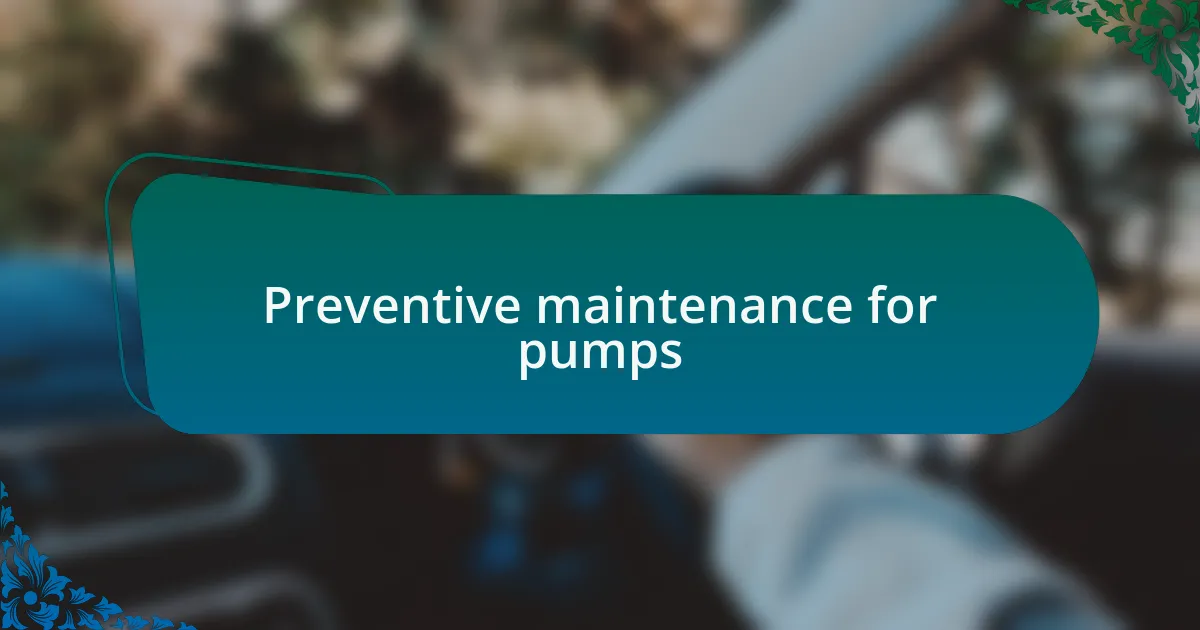Key takeaways:
- Pump issues can arise from various sources, making early diagnosis and regular maintenance crucial to prevent costly repairs.
- Common problems include leaks, air locks, overheating, and abnormal noise or flow rates, all of which require prompt attention to ensure efficiency and longevity.
- Effective troubleshooting involves using the right tools, checking power supplies, inspecting for visible issues, and consulting the pump’s manual for guidance.
- Preventive maintenance, including routine checks and staff training, can significantly enhance pump performance and help avoid major breakdowns.

Understanding pump issues
When it comes to understanding pump issues, it’s essential to recognize that these problems can often arise from a variety of sources. I remember one time at my local car wash, a strange noise emanated from the pump, which led to a frantic search for the root cause. Was it a blockage, or perhaps the motor was failing? These situations can make us feel helpless, yet diagnosing the problem is usually half the battle.
One common issue I’ve encountered is a drop in water pressure, which is often caused by clogs or leaks. When my own wash setup faced a similar scenario, I felt a wave of frustration as I dealt with customer complaints and low service quality. It’s pivotal to check filters and hoses regularly; ask yourself, when was the last time you inspected your pump thoroughly? Small maintenance steps can save you from significant headaches down the line.
Another critical aspect to watch for is unusual vibrations during operation. I distinctly recall a situation where a vibrating pump not only raised concerns about performance but also posed safety risks. It’s important to remember that a little noise might be a simple fix, but neglecting it can result in costly repairs. So, have you ever considered what those sounds indicate? Understanding these signs can significantly improve your operational efficiency and extend the life of your equipment.

Common pump problems

Common pump problems
One of the most frequent pump problems I encounter is leaks. Just last month, during a busy Saturday, I noticed a puddle forming beneath the pump. It was alarming, especially when I realized it was causing a dip in water pressure. Addressing leaks promptly is essential—if left unchecked, they can lead to increased costs and long-term damage.
Another issue that seems to pop up often is air locks. I remember specifically when my car wash faced a sudden loss of pressure, and after some troubleshooting, I discovered an air pocket was to blame. It took a bit of patience to bleed the air from the system, but once I did, the flow returned to normal. Have you ever experienced a situation where everything seemed fine, but then the pressure dropped unexpectedly? Trust me, it can be both perplexing and frustrating.
Lastly, a common pitfall is pump overheating. I’ve had moments when I realized the pump was running much hotter than it should while working on a particularly demanding job. Recognizing the signs early saved me from a major breakdown and potential repair costs. Are you monitoring pump temperatures regularly? It can be a simple checkpoint, but it makes a world of difference in maintaining pump longevity and performance.

Signs of pump failure
Signs of pump failure can sometimes be subtle, but they’re often accompanied by noticeable changes in operation. For example, I once noticed a significant increase in noise levels from my pump during a routine wash. That sound was a clear indicator something wasn’t right and prompted me to inspect the unit. Have you ever ignored an unusual noise, only to regret it later? Trust me, listening to your equipment can save you a lot of hassle.
Another sign I’ve frequently encountered is a fluctuating flow rate. During one busy weekend, I was left scrambling as the water pressure began to pulse rather than flow steadily. It was unsettling to watch the frustration build in customers, and I realized I needed to act quickly. Addressing those irregularities early can prevent a complete system failure—something I’ve learned the hard way.
Moreover, signs like decreased suction can’t be overlooked either. Once, while rinsing off a vehicle, the pump suddenly struggled to pull water from the reserve, leaving me feeling hopeless. I now make it a point to run regular checks on suction performance. Have you ever had to deal with a pump that just couldn’t keep up? Recognizing those clues in advance is essential to keeping operations smooth and customer satisfaction high.

Tools for troubleshooting pumps
When it comes to troubleshooting pump issues, having the right tools at your disposal can make all the difference. I’ve always found a good multimeter invaluable; it helps me diagnose electrical problems quickly. The first time I used one, I realized my pump was receiving inconsistent voltage—an eye-opener that saved me from further frustration later on.
In my experience, a pressure gauge also comes in handy. I remember a day at the wash when my flow rate seemed off. With the gauge, I discovered a blockage in the lines that I would have otherwise missed. Have you ever relied on instinct alone? Trusting your tools can lead to faster and more accurate results.
Another critical tool is a wrench set, especially for tightening any loose fittings or bolts. A few months back, I faced a leak due to a loose coupling. After a quick adjustment, I felt a rush of relief, knowing I had avoided a potential flood. There’s something satisfying about having the right tools and skills to tackle these challenges head-on, don’t you think?

Step by step troubleshooting
Once you have your tools ready, the first step in troubleshooting pump issues is to check the power supply. I recall a day when I was certain my pump had failed, only to find out it was simply an overlooked tripped circuit breaker. Have you ever been quick to assume the worst? Taking a moment to inspect the connections can save you from unnecessary replacement costs and stress.
Next, I always recommend examining the pump for any visible leaks or obstructions. I once spent a frustrating afternoon trying to diagnose a pulsating flow, only to discover a small piece of debris caught in the impeller. What a relief it was to resolve the issue with just a simple inspection! This taught me that sometimes, the answer is hidden in plain sight.
Finally, don’t underestimate the value of consulting the pump’s manual. I remember digging into one while trying to interpret some strange sounds my pump was making. The manual often contains troubleshooting tips that can be lifesavers; it’s like having a guide that knows the ins and outs of your specific model. Have you paused to consult your manual lately? Sometimes, the smallest detail can lead to the biggest breakthroughs.

Documenting pump issues
Documenting pump issues is an essential part of effective troubleshooting. I learned this the hard way when I made a note of recurring pump problems I faced over several months. By writing down the frequency, symptoms, and my attempts at fixes, I not only tracked trends but also identified a pattern that led me to a successful solution. Have you ever considered that your observations could serve as a roadmap to resolving issues?
Equally important is noting the date and time of each problem. I remember a particular incident where my pump seemed to stall during peak hours, but I initially brushed it off. Later, when I compared my notes, I discovered a correlation: the pump struggled mostly on weekends when usage spiked. This information guided me to adjust the scheduling and improve the pump’s performance during critical times.
Don’t underestimate the power of photographs in your documentation. When I encountered a pump issue that seemed intermittent, capturing images of its condition helped me spot problems that were easy to overlook in the moment. These visual records can be invaluable, especially when you’re trying to communicate issues to a technician. How often do you think visuals could clarify a situation that words struggle to convey?

Preventive maintenance for pumps
Preventive maintenance for pumps is crucial to ensure they operate reliably. In my experience, setting up a regular maintenance schedule transformed the way my car wash operated. There was a time when I would wait until a pump malfunctioned before addressing it, but this only led to costly repairs and downtime. Now, I perform routine checks, like monitoring pressure and cleaning filters, to catch potential issues before they escalate. Have you ever considered how a small effort today could prevent a headache tomorrow?
One fascinating technique I adopted is benchmarking my pumps’ performance against ideal standards. I remember when I discovered that one pump was consistently running at a lower efficiency rate compared to the others. By investigating, I found that a simple cleaning and recalibration made all the difference. This practice not only extends the lifespan of the pumps but also enhances overall efficiency. What small changes have you made that yielded significant results?
Another aspect of preventive maintenance involves training your staff. I once overlooked this until a new employee mismanaged pump settings, leading to an unexpected breakdown. Now, I emphasize educating everyone about proper operation and basic troubleshooting techniques. Sharing knowledge empowers the team to act quickly when minor issues arise, ultimately protecting our investment in those pumps. Have you thought about how much a little training could save you in the long run?